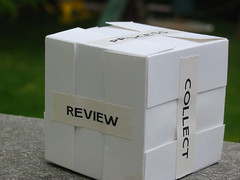Your portable A-Z section - not just for contacts
 Monday, June 19, 2006 at 12:22AM
Monday, June 19, 2006 at 12:22AM You can also use [...] A-Z tabs to track communications and lists. [...] Write the name of each person with whom you communicate frequently at the top: subordinates who report to you, key coworkers, clients, your boss, spouse, children, and so on. As you think of things you need to discuss [...] simply turn to that person's log, filed behind the first letter in the person's name, and make a note.Those familiar with David Allen's Getting Things Done methodology will recognize this as his agenda idea. Allen recommends GTD practitioners keep separate lists for people we "work" with (including spouses and children), and for regular meetings.
My "aha" came when I realized a few things about agendas:
- I had been thinking of the A-Z section as useful solely for contacts.
- I had been using an "Agendas" tab for people/meetings, but using the A-Z section of my planner seemed cleaner. (Don't tell anyone, but I file under first names!)
- I could use agendas for inanimate objects that need regular work. For example, our car needs new wiper blades, but it's not a high priority, so it makes sense to leave it until the next oil change. (In this case, the agenda recipient translates to our mechanic.)
Also, keep track of lists filed behind the letter of the category, such as goals, values, classes to attend, books to read, shopping, errands, gifts, chores, vacation ideas, purchases, birthdays, holidays, and special occasions.Here, GTD-ers will recognize Allen's "checklists" notion. I realize it sounds dumb, but for me the realization that I could put these checklists in the A-Z section (rather than under tabs or in a memo section) was very helpful.
Since reading Stack's article around the beginning of the year, I'm pleased to report that using the A-Z section this way works great! The "only" trick (as usual), is forming the habit to check them at the appropriate time. As with the Next Action lists, I've found that being aware of Transitions helps.
One hitch: Allen's system has you checking your agendas once per week (during the weekly review), and having them spread through the A-Z is an issue. So far it's not been a problem, but that may be a result of my being thoughtful about when something goes on an agenda vs. a next action...
Any feedback or stories are welcome!
Notes
- Happy Father's Day to my fellow dads out there.
- Stack reminds us to put a "Reward if found" sticker in our paper planner. It's not the same has having a regular backup (possible with electronic devices), but at least it's something! And I do like the idea of assuming the person finding it would be honest...

